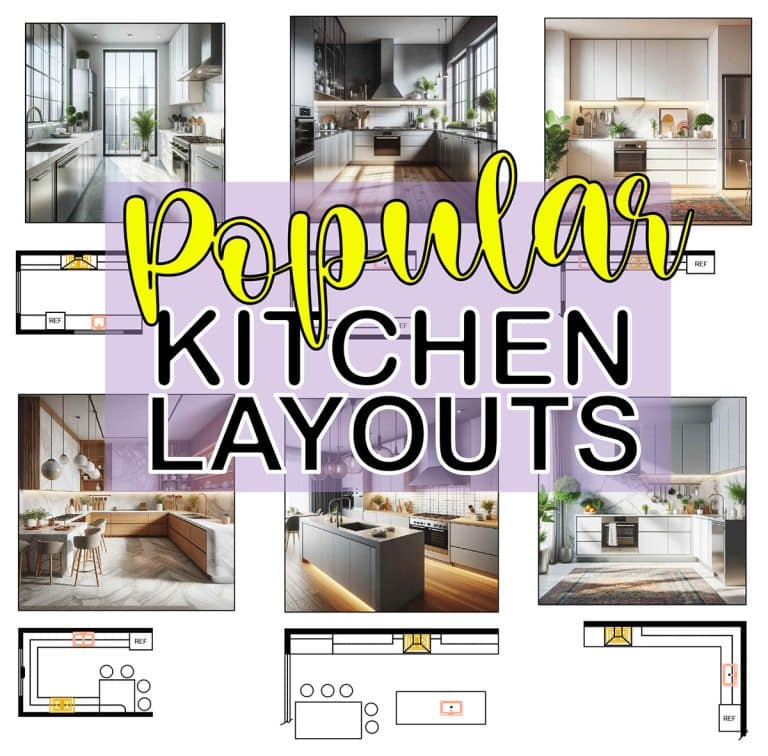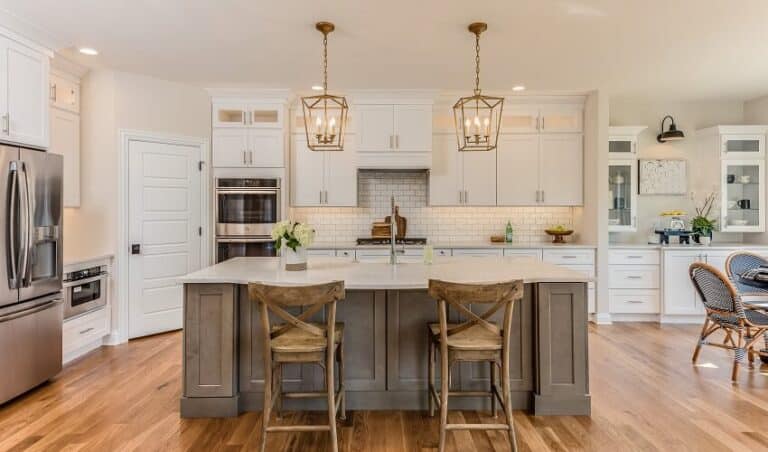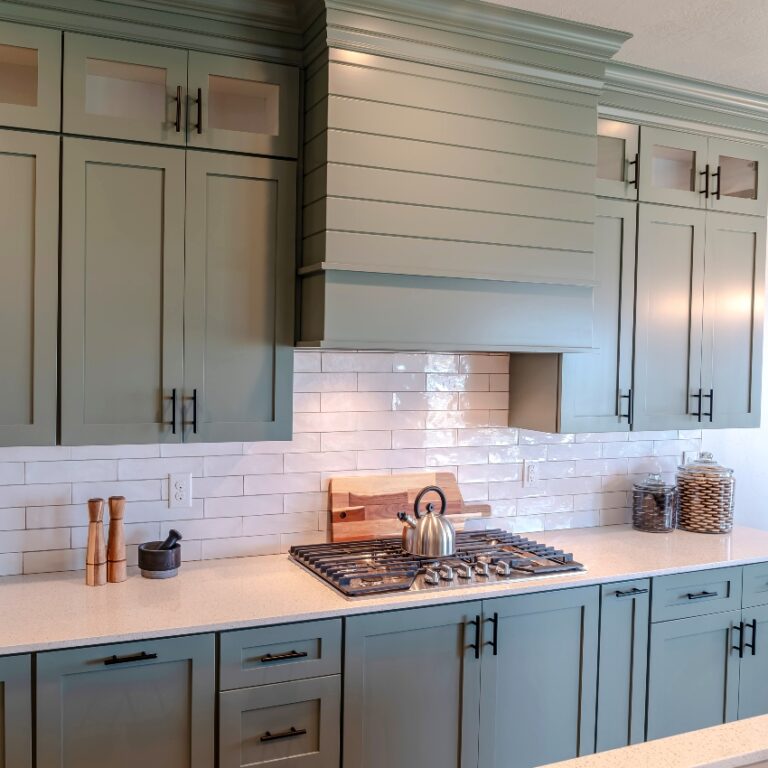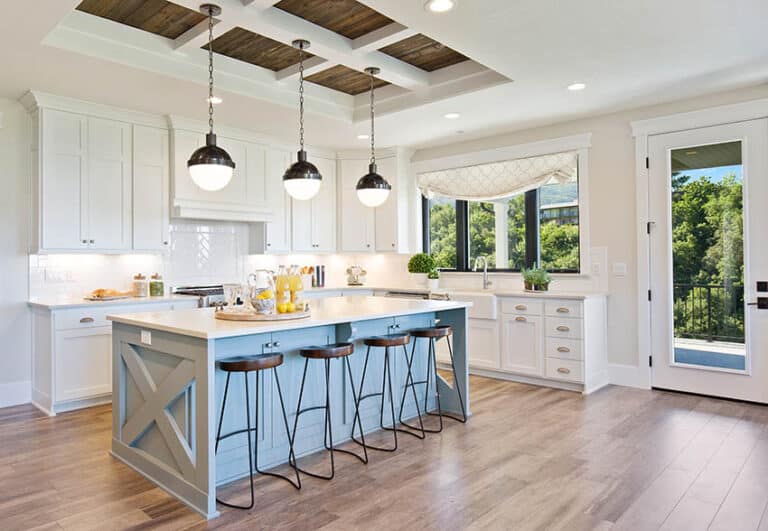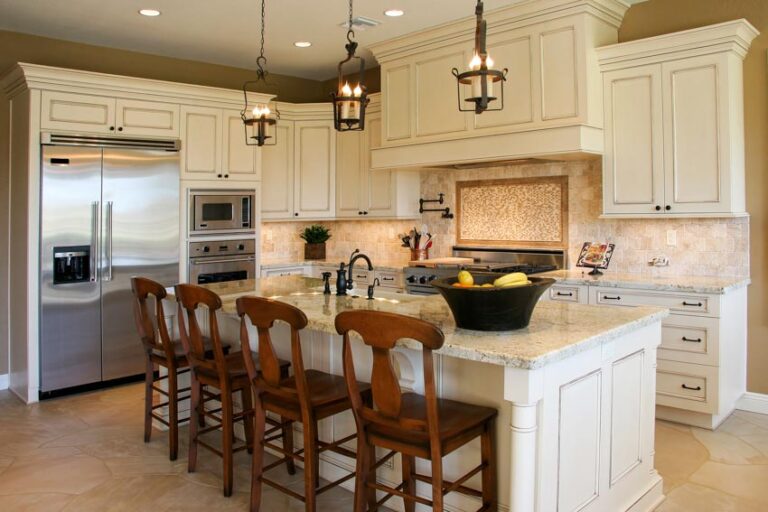19 Types of Kitchen Cabinet Hinges (Design Guide)
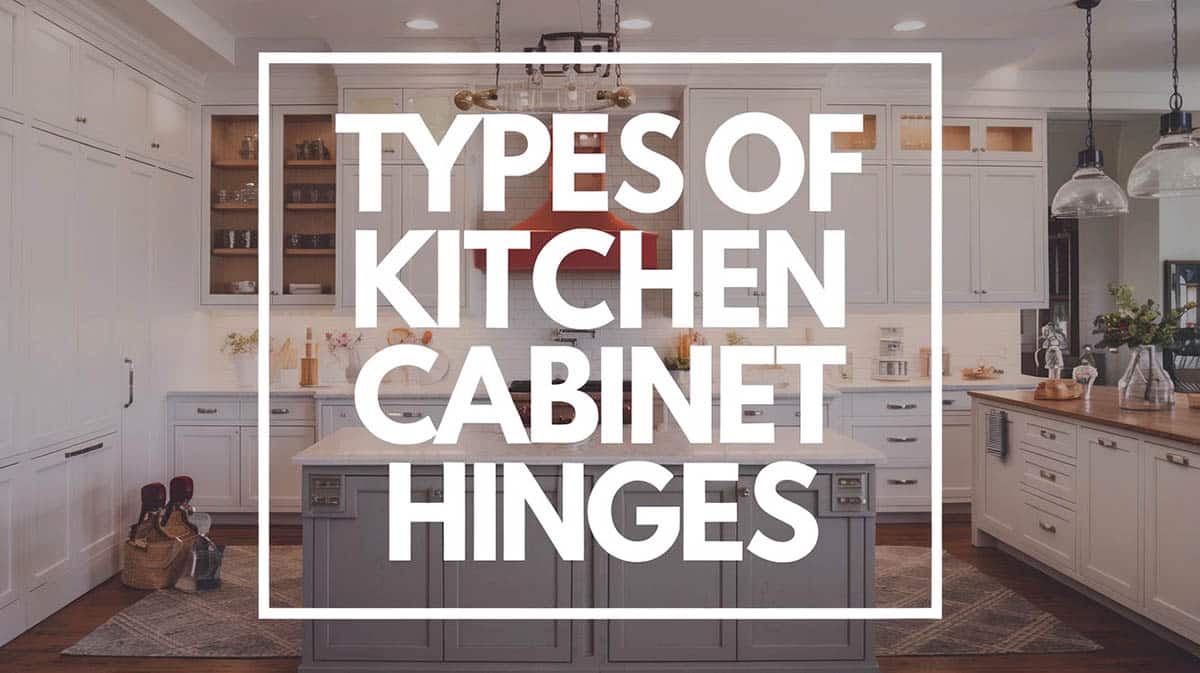
Choosing hinges for your kitchen cabinets seems like a simple task. After all, they’re just hinges, right? Actually, you might be surprised how many options you have when it comes to kitchen cabinet hinges. Kitchen cabinet hinges vary in type, the features they offer, and the finishes. In this guide, we will take a look at the differences in different types of cabinet hinges as well as how to choose, measure, and install the hinges on your kitchen cabinets. (For the different types of kitchen cabinet styles visit this page.
Cabinet Hinge Types
Now that you know the features that some cabinet hinge types have, you’ll want to understand what options you have that hold these features. There are a variety of cabinet hinges that offer a variety of benefits and opportunities to homeowners. We’ll look at many of the most popular options for cabinet door hinges here.
Inset Hinges
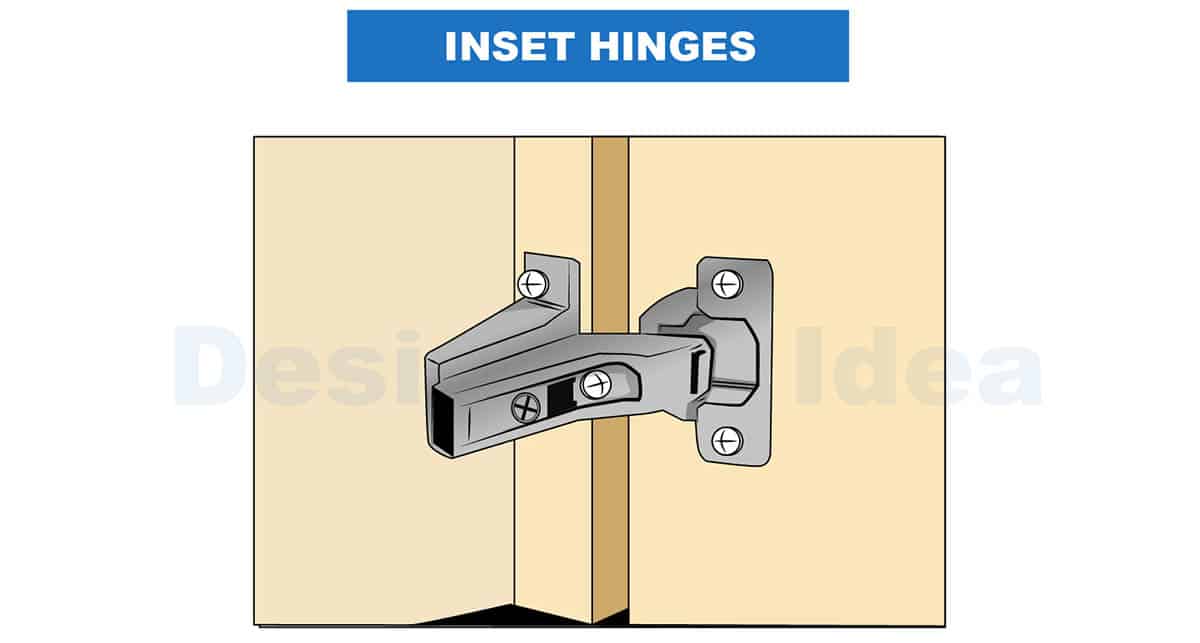
First, let’s take a look at inset cabinet hinges. These hinges include a narrow side and a wider side. The wide side connects to the inside of the cabinet door, while the smaller, more narrow side of the hinge is visible outside of the cabinet. This narrow edge is called the frame wing, while the wider portion is known as the door wing.
Because of its visible nature, inset cabinet hinges are often finished beautifully or employ decorative designs that will add to your kitchen’s design rather than distract from it.
Overlay Hinges

There are two types of overlay hinges – full overlay hinges and half overlay hinges. Overlay, in general, is a reference to how cabinet doors meet cabinet frames. Full overlay swing joints are the type of hinges you’ll want to consider if your cabinet door covers the full face of the cabinet frame. These types of hinges are visible and come in a variety of designs.
A full overlay is for doors that completely cover the cabinet box and are a save spacer because the hinges do not swing into the cabinet space. As far as installation, they vary depending on the design you choose, and they either attach to the door and the face frame or the door and the inside of a frameless cabinet.
The second option you have with overlay hinges is half overlay swinging mechanisms. These hinges are used for partial or half overlay cabinets. For instance, if you have a cabinet that meets another door at a partition or wall, this is the type of cabinet you’d use half overlay hinges for. Half overlay hinges are much smaller than full overlay connectors because they need to allow space for both cabinet doors to open without hitting one another.
Flush Hinges
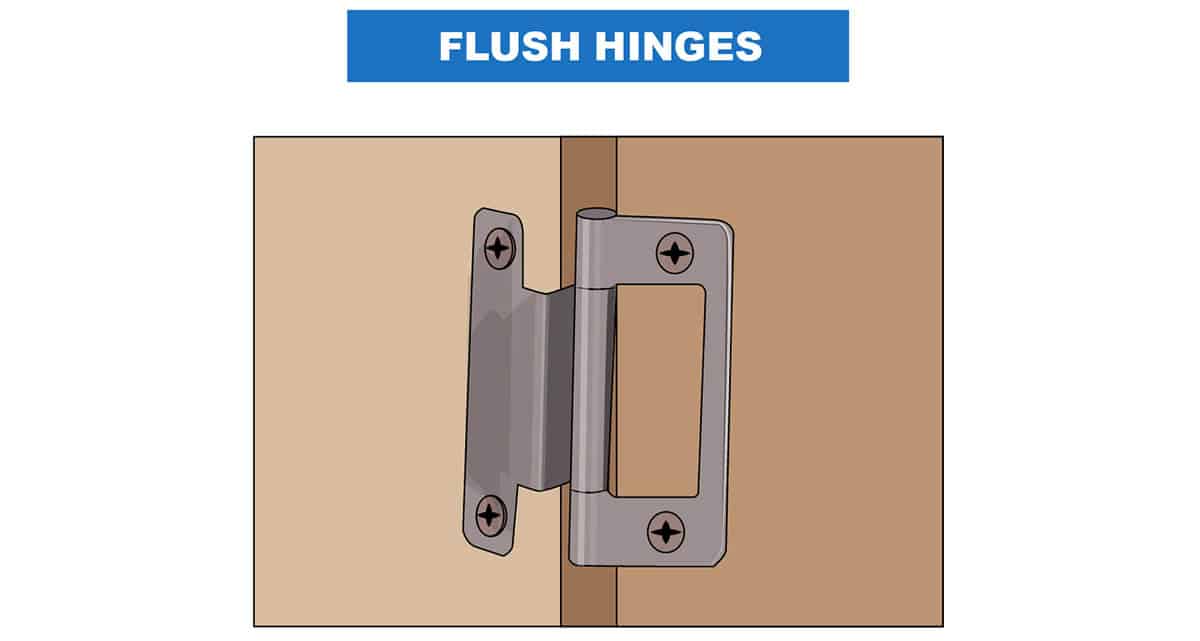
Flush hinges are very similar to butt hinges, which we will look at momentarily. These attach on one side to the cabinet door and on the other side to the cabinet door frame. Unlike butt hinges, these are made up of one side that is a small rectangle and the other side, with a large rectangle with a hole in the center. When the hinge is closed, the smaller side is nestled into this hole.
These aren’t hidden swing connectors. The central point that allows the hinge to open and close will be visible outside of the cabinet. As such, it’s a good idea to look for a hinge with a finish that you like and matches your kitchen.
These flush swinging joints are also appreciated by homeowners who want a simple installation because of the fact that they don’t need a mortise created which we will look at with butt joints.
Face Frame Hinges
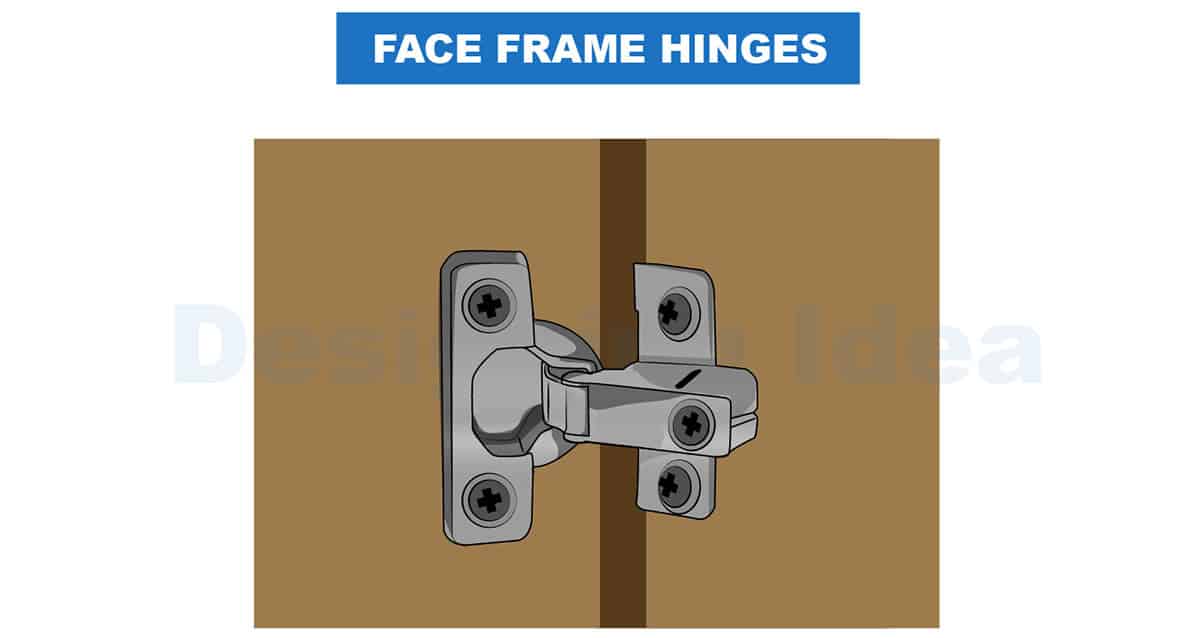
Face frame connectors are one of the most popular options among homeowners in the United States. These shelving latches are used for cabinets that have a bit of a frame existing around the cabinet opening.
These connectors are meant to allow cabinet doors to move when they are positioned so that they are placed in front of the face frame. Face frame connectors do not work for frameless cabinets.
These types of latch points attach on one side to the face frame and on the other wing to the inside of the cabinet door. Face frame connectors are a type of hidden joints, so you don’t have to worry about finding a finish that works for you. These joints are often adjustable, offering greater flexibility when it comes to lining up doors so they look right.
Butt Hinges
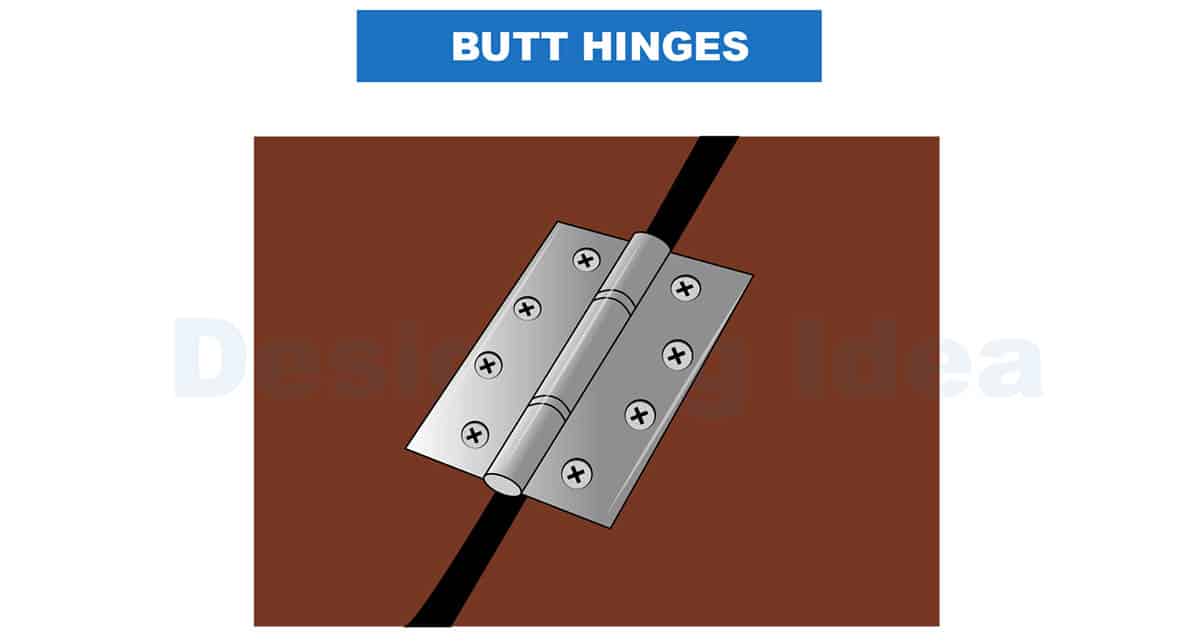
Butt joints are probably the type of hinge you picture when you think of connectors. They are most often used in woodworking projects to create different types of furniture. These are made of two sides with the point of movement in the center, technically known as the knuckle of the hinge. Butt connectors open and close, much like a book. When installed, these attach with one half to the door and one half to the frame, allowing the door to open and close.
The knuckle of a butt hinge is either a central pin or a ball joint that facilitates its ability to open and close. Butt connectors are typically visible outside of the cabinet as the ball joint or central pin does protrude slightly. These are popular choices not only for their reliability and simplicity but because they can be installed rather easily. The only part of the installation that sometimes trips homeowners up is to cut a mortise, or recess, into the cabinet for the butt hinge to sit in.
Barrel Hinges

Another type of shelving latches is a barrel hinge. These connectors appear as cylinders that will exist in the door and the frame. Hidden cabinet pivot points are typically barrel joints because these function without a section being visible outside the door of the cabinetry. Due to this fact, these are a type of hinge that you often see – outside of kitchen cabinet use – on the lids of boxes and chests.
These come in a variety of different sizes. Their depth and diameter measure them, and you will want to make sure that you choose the right size that matches your cupboards.
Barrel hinges are installed a little differently than other types of swinging mechanisms. Two holes are drilled: one in the door and one in the door frame. The barrel hinge is then inserted into the holes and operates by the arm that connects the ends of the hinge.
Invisible Hinges
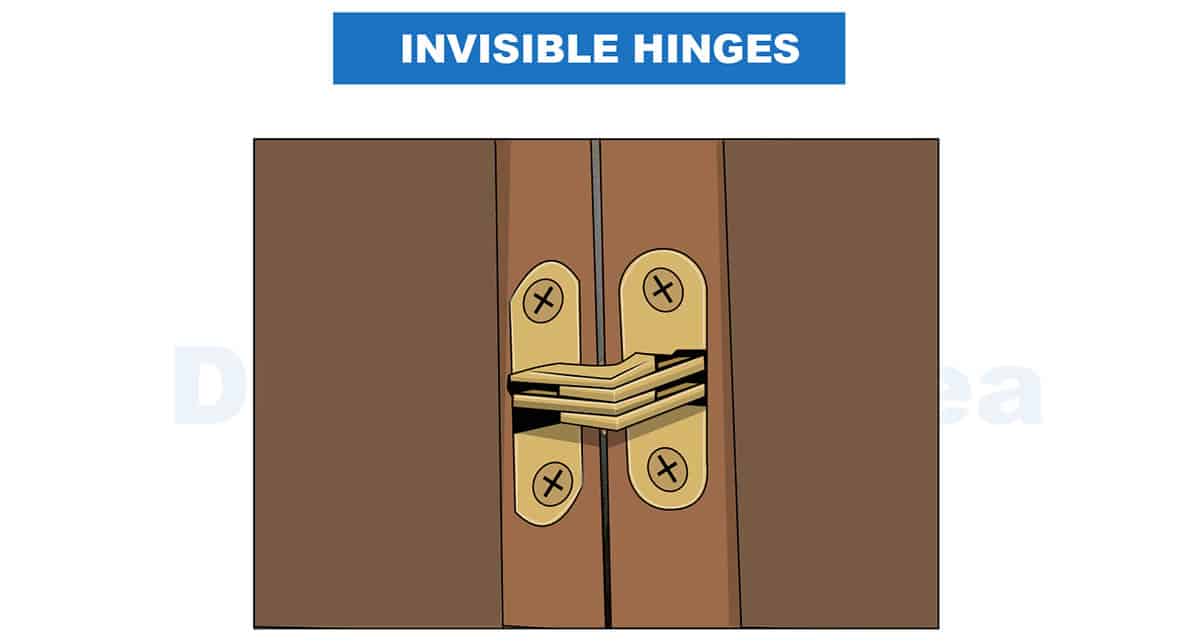
We’ve already taken note that hidden connectors are a feature that you can choose when it comes to your shelving latches, and barrel connectors are often used for this purpose. Another option when it comes to hidden connectors, though, is invisible pivot attachments. Much like hidden connectors, you might also see these referred to as concealed joints as well as European hinges or cup joints.
Invisible connectors are small and made to be hidden from view outside the cupboard and to take up as little space as possible. This is because they are also intended to be mostly hidden from view when the casework is opened as well. As they are hidden, these don’t typically come in different finishes.
These types of kitchen shelving latches are most often used in modern, contemporary, and minimalist kitchens, home theater systems and on metal doors. These are a great choice when it comes to your kitchen storage spaces if you want to give them a floating appearance.
Surface Mount Hinges

Another type of hinge that goes by more than one name, surface mount hinges, are also often referred to as frameless door connectors. This name comes from the fact that these aren’t always mounted on the surface of a cabinet door frame. Instead, these connecting joints are mounted on the inside of the door frame and the back of the door.
Alternatively, surface mount hinges are also sometimes mounted on the outside surface of the frame and door. These types of surface mount connectors are not synonymous with the name frameless door connectors. For now, we’ll focus on frameless door joints. These allow you to open your cabinetry doors without worrying about hitting the frame when the door swings out. Surface mount pivot mechanisms can also usually be adjusted to work with the open and close your door needs. It’s also rather easy to install these joints. This is because, unlike butt hinges, they don’t need a mortise created for their installation.
Strap Hinges
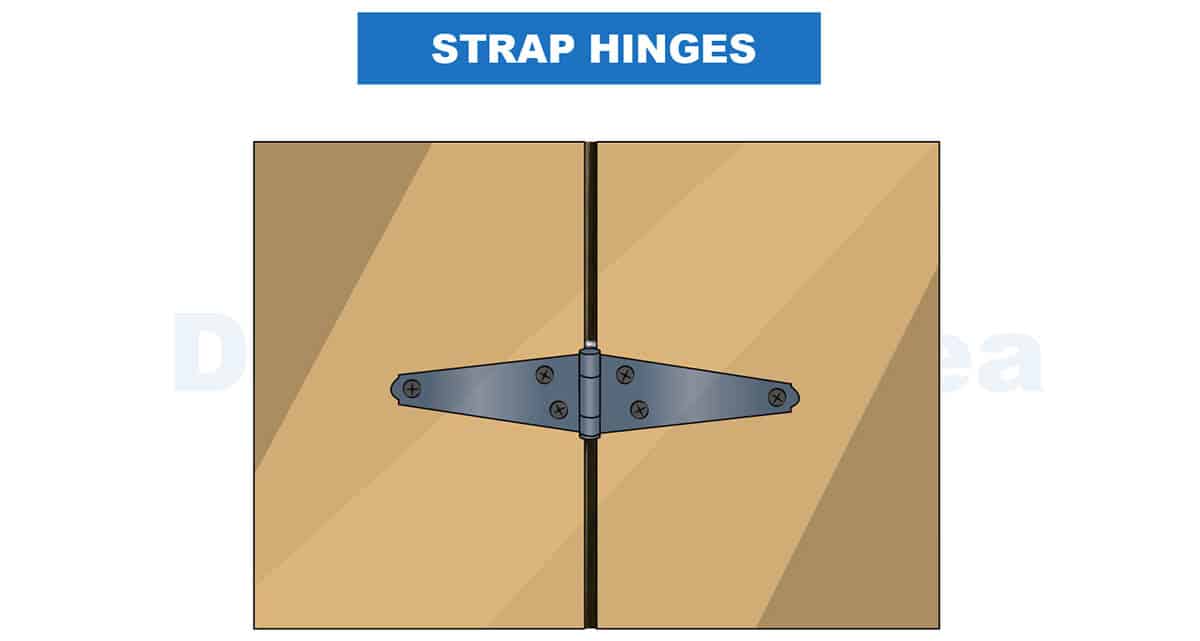
Strap hinges look exactly like the name suggests. These look like a strap, with narrow matching door wings on either side of the knuckle. These joints are mounted on the outside of the kitchen cabinet. Due to this, they are available in many forms with plenty of options on finishes, colors, textures, and even shapes.
These types of swinging mechanisms are appreciated for their versatility. When you are using them for your kitchen storage spaces, you’ll want to use shorter versions of these connectors. These are also often used – in their larger renditions – on gates because they can easily hold a lot of weight. This can make them a great choice if you have heavy pantry doors.
All in all, these types of connectors are one of the most versatile you can choose. The variety of options allows you to find exactly what you want and need for your kitchen storage spaces.
Offset Hinges
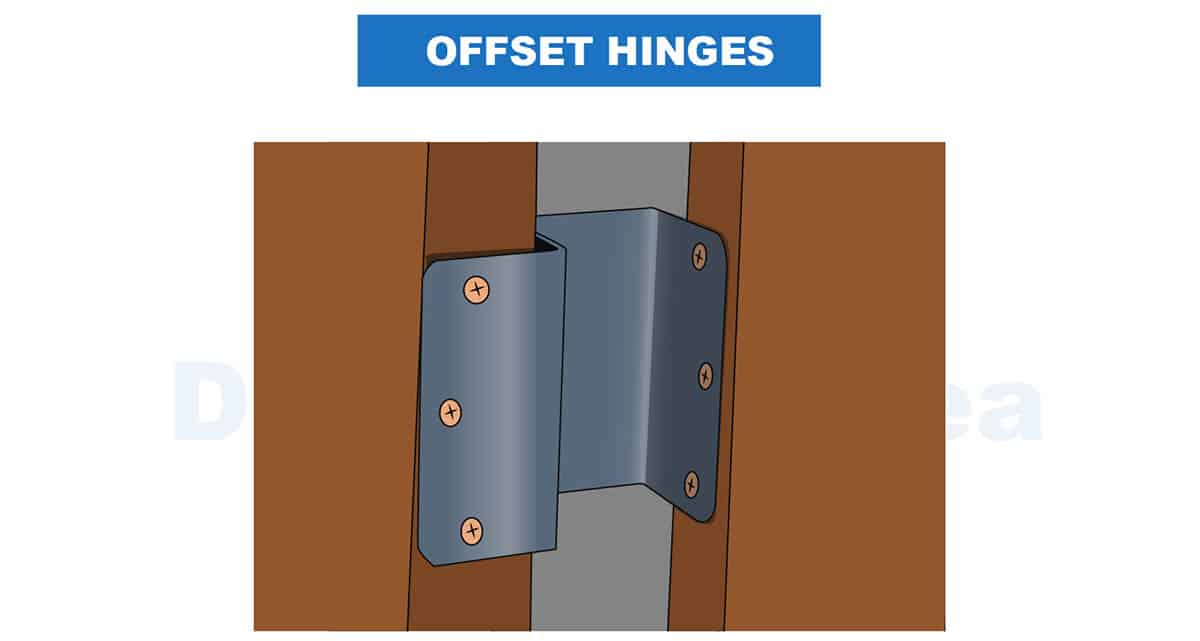
We noted earlier that if you have cabinets that don’t match up perfectly with the door frame, you’ll want to choose swivels that account for that. If your cabinet door protrudes from the frame, offset connectors are one of the best options to make sure they are attached properly.
The first thing you’ll notice when you are looking at an offset hinge is that it isn’t perfectly aligned like, for example, butt hinges. Instead, one side is higher than the other one. This design allows these hinges to reach the protruding or thick cabinet door and attach it to the frame.
Offset shelving latches are visible outside of the cabinet as they attach on the outside of the cabinet door and its frame. Because of this, they offer many options when it comes to decorative touches and finishes.
Corner Hinges

Not all cabinets open at the intersection of the frame and door. While less common, some doors work as bi-fold doors, and lazy Susan cabinets for example. These doors sometimes fit into the corner of a cabinet, but they are sometimes used to cover a single cabinet face.
Corner shelving latches work to offer the range of mobility that these types of cabinet doors need. They usually cover from the inside of one door to the inside of the other and allow these doors to fold open or close. The exact appearance of these hinges can vary.
Wrap Around Hinges
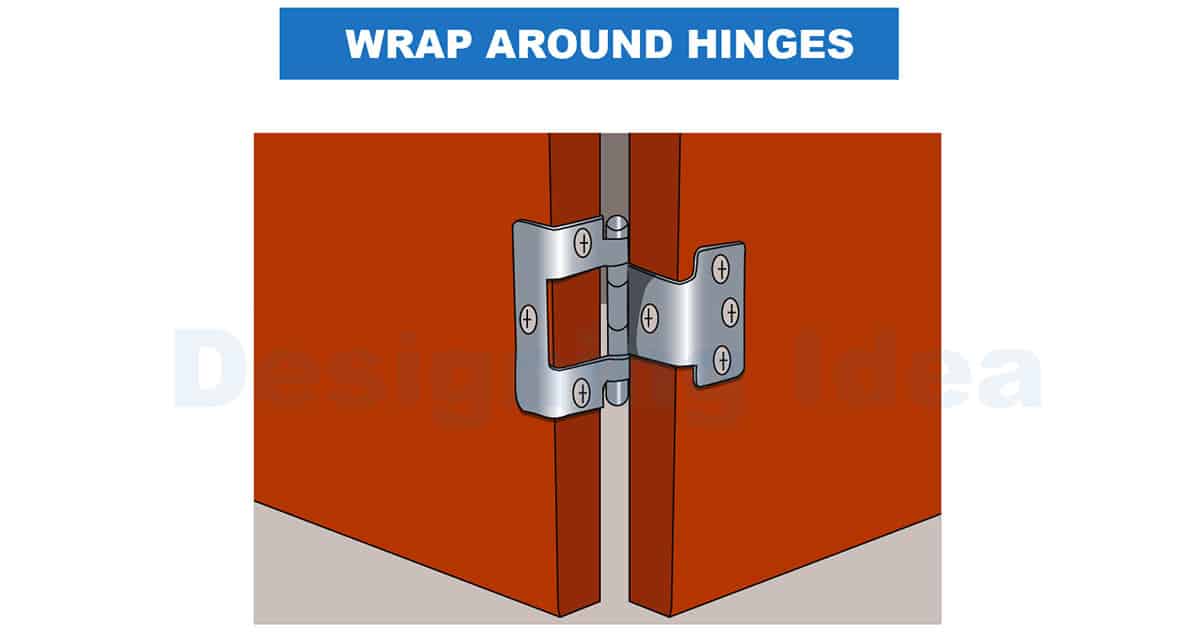
If you have heavy cabinet doors, you’ll want to consider wrap around hinges. Like strap hinges, these types of hinges can carry a significant amount of weight and operate correctly. As they are meant to offer extra support, they have a slightly more complicated positioning than the ones we’ve looked at so far that simply attach to the door and frame.
Wrap around hinges are mounted to the back of your cabinet door and have an additional face that wraps around the door to be visible on the front. Finally, the frame wing connects to the cabinet door frame. This design is meant not only to support your heavy cabinet doors but to make sure they are kept stable as well.
These are known as full wrap around hinges. Partial wrap around hinges are another option. This type of wrap around hinge only connects to two sides of the frame and then screws to the edge rather than three sides of the frame. As that design suggests, these hinges are highly visible. So, they are available in a number of options for finishes.
Hinge Features
When you are considering cabinet connectors, there are certain features that you should look out for. For instance, do you want a decorative hinge that will add to the appearance of your cabinets, or do you want something entirely hidden? Maybe you want your cabinets to close by themselves or a fail safe to ensure that your cabinets can’t be slammed. These are features you’ll want to consider before purchasing cabinet pivot joints.
Hidden Hinges
Hidden cabinet pivot attachments, which are sometimes referred to as concealed cabinet connectors, are exactly what they sound like. They are “hidden” from view as they are mounted inside the cabinet door without a portion that protrudes outside the cabinet door. Since they won’t be seen, they are a purely functional option that doesn’t usually offer a variety of finishes or decorative touches. This gives the cabinet an appearance as if it’s floating in place.
Many homeowners enjoy these types of connectors because they don’t have to worry about choosing the right design or if the hinge will clash with their kitchen decor. This makes them a great choice if there are any imperfections in the cabinet’s measurements that off-center or crooked visible pivot attachments would attract unwanted attention. Since these don’t add to the decor of a kitchen, they are sometimes used in addition to faux pivot hardware that sits outside the cabinet.
Soft Close Hinges
A soft-closing cabinet hinge helps to ensure that the sound of slamming cabinets isn’t something that you have to deal with. These stifle this noise by making sure your cabinets close slowly. When you use soft close cabinet pivot points, you’ll need to use a little more force than you’d typically need to use with other styles of connectors.
The way these work is to control the movement of the cabinet door once it is pushed past a particular point. These connectors use a simple hydraulic system to create a vacuum that pulls the door shut gently.
Similar to and often confused with soft close shelving latches are self-closing or spring-loaded storage chest connection points. These use a spring that uncoils a bit when the door is opened, and when released, the spring coils back into place, shutting the cabinet. These might also use a hydraulic system rather than a spring. These create a vacuum that pulls the door shut when it’s not being held in place.
Self-closing joints do have a drawback that soft-closing cabinet pivot points don’t. If a self-closing hinge of either design malfunctions or breaks down, a door can potentially be sealed shut until the joints are removed.
Adjusting Hinges
Certain types of cabinet pivot points are made to be able to be adjusted after they are installed. These are known as European shelving latches which we will look at more in-depth on what they are and how to adjust them later.
If you are concerned about shelving latches with odd measurements that don’t work for well-placed connectors but you still want a visible hinge, one option is to use functional decorative joints in tandem with hidden joints. This way, you can have even, visible rotational joints that give you the look you want as well as operating swinging mechanisms.
Heavy Duty Hinges
Heavy duty shelving latches are more often used in industrial settings than residential ones. For instance, heavy-duty doors in research laboratories, armored vehicles, shipping containers, and loading doors are likely to use heavy-duty connectors.
If these are used in a residential application, it is often for heavy or oversized cabinets. This isn’t too often, though, because heavy-duty connectors are recommended for doors of 1,000 pounds or more.
When it comes to size, heavy-duty connectors measure about ¼-inch thick. As far as type, heavy-duty pivot hardware is an umbrella term. Instead, these are often heavy-duty versions of connectors; most times, pivot joints or barrel connectors are used.
Decorative Hinges
There is a dual meaning when it comes to the term “decorative hinges.” It’s important to discern these differences and know which definition the hinge you are considering fits before making a purchase. The first meaning is that the hinge serves decorative and functional purposes. These connectors fit into the cabinet and help the cabinet open and close as you would expect a hinge to.
In addition, they are meant to look especially attractive on the section that is present outside of the cabinet. These are often used with a type of hidden hinge. When it comes to the latter meaning, you may also see them referred to as a faux hinge. These don’t actually serve a purpose when it comes to opening and closing the cabinet door but serve a purely aesthetic purpose.
These are often used in one of two ways. For one, they are used in addition to non-decorative connectors such as self-closing or soft-closing joints that don’t carry an aesthetic purpose. The second use is on decorative cabinets – cabinets that don’t actually open – as pure decoration.
Types of Hinge Finishes
We’ve mentioned a lot about decorative touches to shelving latches throughout, explaining your options on types. To help you further understand what your options are, let’s take a moment to look at types of cabinet hinge finishes. The most common finishes on cabinet door connectors include the following;
● Black
● Brass – Brass cabinet hardware matches well with kitchens with dark cabinets.
● Chrome
● Copper
● Nickel
● Stainless Steel
● Steel
● White
Much like choosing a kitchen paint color, you can buy samples of the finishes you are considering to see how they would look with your kitchen decor before you commit to buying your new joints.
In addition, there are a variety of kitchen cabinet design software available to help you visualize your design before purchasing any materials.
European Hinges
While finishes are a great way to make sure that your new cupboard storage links match your kitchen decor, there are styles of joints that don’t typically call for a search for different finishes because they aren’t visible when the cabinet door is closed. European cupboard storage links are hidden joints that have ever-growing popularity. They come in a variety of styles, though. You can find European connectors that are soft close, joints for larger or thicker doors, and more.
Guide to Replacing Hinges in the Kitchen
Replacing these can differ a little depending on the type of cabinet hinge you were using and the type of drawer swing connectors you are replacing them with. The most important thing to consider before starting is to determine the type of kitchen cabinet doors you have. There are many different styles of doors such as full-overlay, partial overlay, inset, raised panel and recessed panel doors to name a few. You will want to make sure the hinge you purchase is for your style of cabinet.
Measuring for Swing Joints
When it comes to choosing and installing drawers, it’s absolutely crucial that you get it right. Luckily, it isn’t difficult to get the right measurements once you know how to do it.
To start, put the cabinet door where it will set once it’s hinged on. Take a piece of painter’s tape and place it stretching from the door to the frame where the hinge will go.
“Open” the cabinet and measure the distance from the tape’s edge to the cabinet opening – this is the overlay measurement you’ll need to choose the right joints.
Make sure you get the right hinge for the side of the cabinet they’ll be on too! Connecting joints on the right will be noted RH and on the left, LH.
How to Install Hinges
The exact steps for installing a drawer hinge will vary slightly depending on what type of drawer hinge you are using. As such, here, we will take a look at more general instructions that may need to be slightly modified depending on the requirements of the hinge that you are using.
To start, you’ll need to remove the old pivot joints from the cupboards. You can do this rather simply by unscrewing the connecting joints from both the door and the frame.
The old holes that the screws occupied should be filled to ensure that the new latch points aren’t being installed into worn holes. Some suggest doing this by gluing a small dowel into the hole and sanding it flush with the rest of the frame.
Next, you’ll want to temporarily place the connecting joints where they are meant to sit on the door and align it with the edge. Mark where the connecting joints will line up then remove the connectors.
Drill guide holes partially into the cupboard door that are smaller than the screw and screw the connecting joints into the door.
Use a straightedge and clamp to ensure that the cupboard doors are level where they are meant to sit on the drawer and mark the guide holes. Move the doors out of the way to drill them and then replace the doors to screw the joints in.
Here’s a video covering the process of installing kitchen drawer swing connectors:
How to Adjust Hinges
European drawer swing connectors are designed in such a way that adjustments can be made if needed. When you open your cupboard door, you’ll notice that your connecting joints have four screws in an almost cross formation with one on top, one on the bottom, and two side by side between them.
If you want to adjust your storage units horizontally, adjust the screw in the center that is closest to the hinge knuckle. Turning it clockwise will bring the door and the edge of the storage units closer together.
For a vertical adjustment, you are going to use the top and bottom screws. When these screws are loosened, the door will shift slightly downward. Make sure that the screws are still in enough to support the door.
The final screw is used to adjust the door forward and backward. If the door doesn’t have enough of a gap, the door won’t close correctly.
Where to Buy Hinges Online
When you are looking for where to buy closet hinge mechanisms, you have a lot of options. Your local hardware store probably has plenty of options but in the internet age, you’re probably going to shop online. In addition, shopping online will give you a wider variety of options.
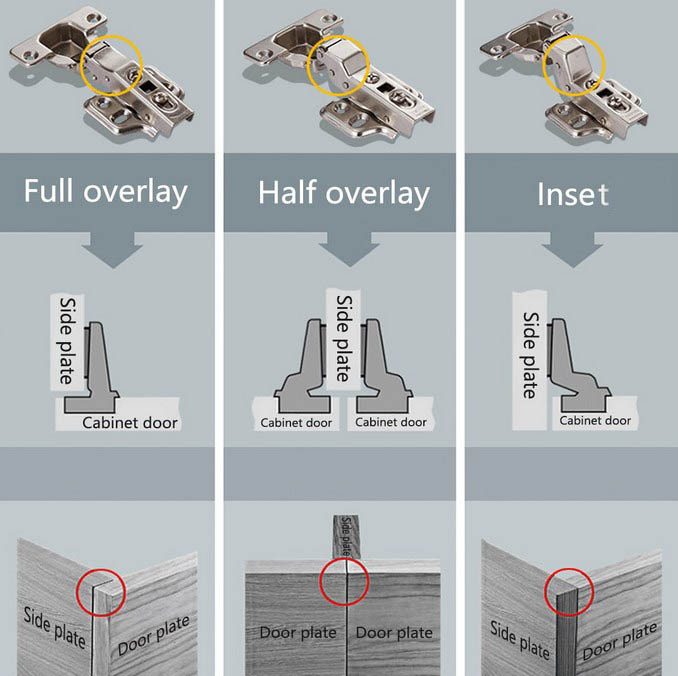
See these hinge types on Amazon
The most obvious choice is to visit the online counterparts of hardware stores. The online stores by Wayfair, Lowe’s, or Home Depot are great places to find the most common types of kitchen storage unit latch connectors. You can also look at sites that aren’t dedicated to hardware such as Amazon as well.

